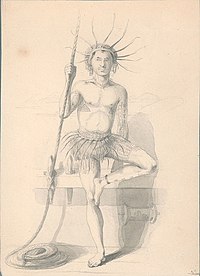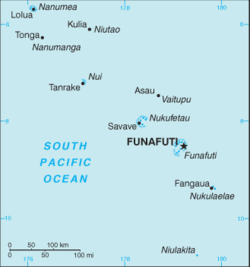History of Tuvalu
[25][26] Keith S. Chambers and Doug Munro (1980) identified Niutao as the island that Mourelle also sailed past on 5 May 1781, thus solving what Europeans had called The Mystery of Gran Cocal.
La Princesa was short of supplies but Mourelle was forced to sail on – naming Niutao, El Gran Cocal ('The Great Coconut Plantation').
[27] In 1809, Captain Patterson in the brig Elizabeth sighted Nanumea while passing through the northern Tuvalu waters on a trading voyage from Port Jackson, Sydney, Australia to China.
[25] In May 1819, Arent Schuyler de Peyster, of New York, captain of the armed brigantine or privateer Rebecca, sailing under British colours,[28][29] passed through the southern Tuvaluan waters while on a voyage from Valparaíso to India; de Peyster sighted Funafuti, which he named Ellice's Island after an English politician, Edward Ellice, the Member of Parliament for Coventry and the owner of the Rebecca's cargo.
[46] By the 1870s J. C. Godeffroy und Sohn began to dominate the Tuvalu copra trade, which company was in 1879 taken over by Handels-und Plantagen-Gesellschaft der Südsee-Inseln zu Hamburg (DHPG).
Louis Becke, who later found success as a writer, was a trader on Nanumanga, working with the Liverpool firm of John S. de Wolf and Co., from April 1880 until the trading-station was destroyed later that year in a cyclone.
[50] H. M. Ruge and Company, a German trading firm that operated from Apia, Samoa, caused controversy when it threatened to seize the entire island of Vaitupu unless a debt of $13,000 was repaid.
[89] Harry Clifford Fassett, captain's clerk and photographer, recorded people, communities and scenes at Funafuti in 1900 during a visit of USFC Albatross when the United States Fish Commission were investigating the formation of coral reefs on Pacific atolls.
Eventually the belief system was centred on the priests or spirit-masters (vaka-atua or vakatua), who were the intermediaries between the people and spirits, deities and fetish objects, such as an unusual red stone called the Teo.
Although Waters, and other traders, such Charlie Douglas at Niutao and Jack O’Brien at Funafuti, had economic motives in destroying the ancient religions so that the islanders were more focused on the copra and coconut oil trade.
[100] Westbrook, a trader on Funafuti, reported that the pastors impose strict rules on all people on the island, including demanding attendance at church and forbidding cooking on a Sunday.
[104] Captain Werner imposed trade and friendship treaties on the islanders giving Germany most-favored-nation treatment, and he intervened to assist the DHPG trader at Vaitupu, Harry Nitz, in a dispute over land.
The first Resident Commissioner was Charles Richard Swayne, who collected the ordinances of each island of Tuvalu that had been established by the Samoan pastors of the London Missionary Society.
[119] After World War II,[119] Kennedy encouraged Neli Lifuka in the resettlement proposal that eventually resulted in the purchase of Kioa island in Fiji.
[122][125] The construction of the airfields resulted in the loss of coconut trees and gardens, however, the islanders benefited from the food and luxury goods supplied by the American forces.
[138] Corporal Fonnie Black Ladd, USMCR, persuaded them to get into dugouts, then a bomb struck the church shortly after;[139][140] in that raid, 2 American soldiers and an elderly Tuvaluan man named Esau were killed.
The Resident Commissioner was now required to consult the Executive Council regarding the creation of laws to making decisions that affected the Gilbert and Ellice Islands Colony.
[178] Atufenua Maui and educators from Japan have worked on the implementation of an e-learning pilot system at Motufoua Secondary School that applies the Modular Object Oriented Dynamic Learning Environment (Moodle).
[188] Church and community buildings (maneapa) are usually coated with white paint that is known as lase, which is made by burning a large amount of dead coral with firewood.
Tuvaluan women continue to make Te titi tao, which is a traditional skirt made of dried pandanus leaves that are dyed using Tongo (Rhizophora mucronata) and Nonu (Morinda citrifolia).
[212] The storm surge created a wall of coral rubble along the ocean side of Funafuti and Funafala that was about 10 miles (16 km) long, and about 10 to 20 feet (3.0 to 6.1 m) thick at the bottom.
[216] Prior to the formation of Cyclone Pam, flooding from king tides, which peaked at 3.4 m (11 ft) on 19 February 2015, caused considerable road damage across the multi-island nation of Tuvalu.
[224][225] Owing to the severity of damage in the nation, the local chapter of the Red Cross enacted an emergency operation plan on 16 March which would focus on the needs of 3,000 people.
[219] Prime Minister Sopoaga stated that Tuvalu appeared capable of handling the disaster on its own and urged that international relief be focused on Vanuatu.
Only two weeks ago, a period when the weather was normal and calm and at low tide, unusually big waves suddenly crashed ashore and flooded most part of the capital island.
We once again appeal to the industrialized countries, particularly those who have not done so, to urgently ratify and fully implement the Kyoto Protocol, and to provide concrete support in all our adaptation efforts to cope with the effects of climate change and sea level rise.
[236]Addressing the United Nations General Assembly in September 2008, Prime Minister Apisai Ielemia stated: Climate change is, without doubt, the most serious threat to the global security and survival of mankind.
"[241] Marshall Islands President Christopher Loeak presented the Majuro Declaration to the UN Secretary-General Ban Ki-moon during General Assembly Leaders' week from 23 September 2013.
[243] Prime Minister Sopoaga said in his speech to the meeting of heads of state and government: Tuvalu's future at current warming, is already bleak, any further temperature increase will spell the total demise of Tuvalu….
[244]Enele Sopoaga described the important outcomes of COP21 as including the stand-alone provision for assistance to small island states and some of the least developed countries for loss and damage resulting from climate change and the ambition of limiting temperature rise to 1.5 degrees by the end of the century.
















